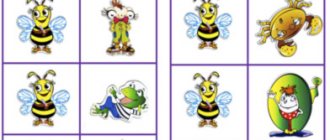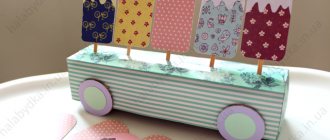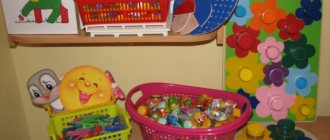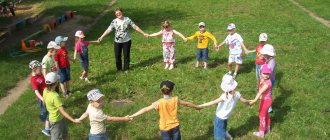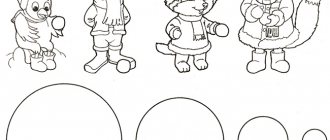If you are the parent of a preschooler, you have probably already thought about starting school. How to help adapt to new conditions, master writing, counting and reading.
In this material we will help you understand the main aspects of developing writing skills, find out possible mistakes and how to avoid them. We'll tell you about exercises and educational games that will help prepare your hand for writing.
Formation of writing skills in children
Writing is one of the ways of speaking. The process of developing a skill is long and complex. It starts at the age of two or three and continues until the age of seven, when children enter first grade. Many parents start preparing their children for school in advance. They buy notebooks with copybooks of letters, and do not understand why many days of hard training do not produce results.
It is important to know the difference between preparing to write and learning to write. In preschool age, full-fledged writing is impossible due to age-related characteristics of the structure of the nervous system. At this stage, the emphasis is on general physical development and strengthening the muscles of the hand, on developing perseverance, coordination of body movements, concentration, and visual orientation.
Writing skills are developed in three stages:
- analytical - thinking about each movement and analyzing it, for example, how it is more convenient to take the handle, with what force to press, etc.
- synthetic – combining elements into a holistic process, conscious thinking about each step, visual control of each action;
- automation means that the skill has been formed: the child, without thinking, completes written tasks, hand movements are smooth, effortless.
In preschool age, the child gains graphic experience, learns to use written objects and observe hygiene rules. The child acquires the skills to correctly tilt a notebook, write individual letters and words of the required size and at the required angle, and correct body position while writing.
What is important for preparation
In order to facilitate the process of developing writing skills, reduce stress and not cause a negative attitude towards school, it is necessary to train the hand from the age of three.
General physical development
Good physical fitness plays an important role in the formation of beautiful handwriting. Strengthening the muscular system promotes endurance and allows you to sit at your desk during the lesson. Strong back muscles prevent curvature of the spine and maintain correct posture. Developed muscles of the shoulder girdle and arms relieve rapid fatigue, trembling and muscle spasms.
The child develops physically during active games on the street, riding a bicycle or scooter, jumping on a trampoline or inflatable slide, etc.
Motor skills
These are coordinated movements aimed at performing some action.
Motor skills are divided into:
- large – this is coordination of movements, maintaining balance, awareness of the position of the body in space: walking, running, standing up, sitting down, lying down, turning;
- fine - precise movements of the fingers.
To develop writing skills, it is equally important to pay attention to the development of both types of motor skills. When writing, the small muscles of the hand and the large muscles of the body are used to keep the body in a straight position.
Orientation in space
It will be easy for a child to navigate in a notebook or on a piece of paper if he knows such concepts as right-left, top-bottom, side, center, corner. To do this, when talking with your baby while dressing and undressing, walking, bathing, feeding, pay his attention to what the right and left arms or legs are doing. Ask what is seen ahead and what is left behind.
Graphic skills
In the process of drawing, the muscles of the hand are trained. Hatching, coloring, and drawing in cells develops the skill of observing boundaries, writing hygiene, and the ability to navigate in space.
"Skillful Hands"
An integrated approach to developing skills, which includes various kinds of crafts, appliqués, modeling, design, knitting and embroidery. Fine motor skills, spatial orientation, perseverance, concentration, and accuracy are improved.
What skills are needed?
Preparing your hand actually involves more than just being able to use a pen and pencil. To help your child prepare for writing, you need to teach him:
- hold a pen or pencil correctly (this is discussed in detail in this article);
- navigate on a sheet of paper (explain to him where the center is on the page, where the upper right corner is, the lower left corner, etc.);
- deftly control the small muscles of the fingers (develop fine motor skills);
- coordinate the accuracy of hand movements in horizontal, vertical, and diagonal directions;
- draw lines smoothly, without jerking or strong pressure;
- work with a pen for some time without fatigue.
The last two skills are developed with regular practice: as the baby learns to apply even force to press on the paper, the hand will get less tired.
A child will learn to navigate the page if he is systematically asked to draw in a certain part of it (top left, center, bottom right, etc.). First, he needs to explain what a cell is in the notebook and how many sides it has. You can count the cells in a row or column (this also reinforces the counting skill).
Exercises to prepare your hand for writing
There are many interesting activities for preschoolers that help prepare for writing:
- drawing with pencils on paper;
- prettification;
- tracing drawings along the contour;
- the use of special notebooks with copybooks of loops, hooks, figures, lines;
- shading of figures;
- drawing with multi-colored crayons;
- different types of mosaics;
- construction games with parts of different sizes;
- cutting with scissors;
- sorting beads, buttons by color or size;
- threading laces through holes;
- braiding braids from multi-colored ropes;
- winding ropes and knitting threads into a ball;
- spinning the spinning top toy, spinning top;
- stringing beads on a thread;
- simple embroidery elements;
- fastening and unfastening buttons, snaps, zippers;
- finger painting using paints, dry crumbly finely ground cereals, flour;
- modeling from plasticine, dough;
- games in the sandbox or with kinetic sand;
- gluing small parts using tweezers;
- drip drawing using a pipette;
- opening and closing the lock with a key;
- unscrewing and tightening screws and nuts with fingers and a screwdriver;
- sewing on a button;
- making applications from colored paper, pasta, natural materials (beans, peas, leaves, flowers, sticks, straws, matches, etc.);
- origami;
- drawing using stencils;
- finger theater games.
Fine motor skills and writing
By developing fine motor skills, we prepare the hand for writing long before the baby needs it. At the same time, the ability to master writing instruments is acquired easily and unnoticed by the baby.
How to develop fine motor skills? First of all, offer the baby various manipulations with small parts. For example, at 3 years old, when the baby is still poorly oriented in space (and therefore on a piece of paper), these can be games with the following toys:
- mosaic;
- constructor;
- spinning top;
- cubes.
In addition, it is useful to perform finger exercises (read more here) and massage the hands. The following activities will help with this:
- winding balls;
- lacing;
- drawing;
- sorting of cereals;
- stringing large beads or buttons onto a fishing line.
Such tasks captivate the child, and he hones the necessary skills without even noticing.
From 4 to 5 years old, you can offer your child such an exciting activity as drop therapy - drawing with a pipette into which diluted watercolors of the desired colors are collected. The drawing is done using these drops.
At the same age, a child can master plasticine printing. This is not just modeling, but a kind of drawing with plasticine on the surface, or applique. It can be done first by regular smearing, then in the form of a mosaic, an application of thin plasticine flagella - plain or mixed from several colors. You can use natural and other available materials for decoration.
Exercises
Regular exercises will help strengthen your hand muscles and add confidence in writing:
- "Blooming Flower"
The hands are clenched into fists and connected together. The thumbs are straight, touching the lateral surfaces. Then the fingers are straightened, the palms are slightly moved away from each other, the wrists are connected. Reminds me of an unopened bud. The flower begins to open - without separating the wrists, the hands are moved to the sides, the fingers are spread out.
- "Duckling fingers."
The palm is open, fingers spread. The index finger is curled into a hole at the base of the thumb. The pads of the first finger alternately touch the middle, ring and little fingers, like the beak of a duck.
- "Tight hugs."
The fingers of both hands are spread out, pressing the tips against each other with force for 5 seconds. Then they cross into a lock, pressing their palms tightly. Count to 5. After the exercise, shake your hands to relax the muscles.
- "Chair".
Place your palms together, fingers together, looking up. The right hand slides downwards along the left. When your fingertips reach the top of your left palm, you need to stop. By pressing at the base of the fingers of the left hand, the hand bends at the wrist joint. In this case, the fingers remain in a vertical position. The curved palm resembles a chair with a backrest.
- "Welcome handshake."
The index, middle and ring fingers of the right hand are pressed against the palm. Each finger of the left hand is greeted with the thumb and little finger, as if shaking with both hands during a greeting.
How to teach a child to hold a pen correctly
It is important that the child learns how to properly hold a pen and pencil before entering school. Correcting mistakes and retraining the grip is difficult. Incorrect position of the fingers, tilt of the pen and rotation of the hand make handwriting uneven and illegible, cause rapid hand fatigue, and affect posture.
What a correct grip looks like:
- the handle lies between the thumb and middle finger, pressed on top with the index finger;
- the distance to the writing rod is about two centimeters;
- a straight line can be roughly drawn through the hand, wrist and elbow joints;
- the top of the pen or pencil points to the child's shoulder.
The most common mistakes
Preschool children, when they begin to master working with stationery items, make the following mistakes:
- The child holds a pencil or felt-tip pen with his whole hand, clenching it into a fist.
- In a three-finger grip, the thumb is bent and directed perpendicular to the index finger to its middle phalanx.
- The pen rests on the ring finger and is held by the middle, index and thumb.
- The brush bends inward, with the top edge of the object pointing away from you.
- The child holds the handle with all fingers (like a pinch).
- The fingers are located near the stylus, or far away so that the hand hangs over the table.
- When moving, it presses on the paper too much, leaving tears, or too lightly.
Methods to avoid mistakes
The following methods will help you avoid mistakes in learning to retain written objects:
- It will be easier to grip a pencil correctly if you hold a small piece of paper with your ring and little fingers.
- Draw a dot on the middle finger that will indicate the location of the pen.
- The finger game “building a house” will focus on three-finger holding: the handle is held between the middle and thumb; the index finger rises freely and can hit the handle like a hammer.
- Be sure to focus on the direction of the top of the pencil towards the child’s shoulder.
- To generate moderate pressure, use soft pencils or felt-tip pens.
- For optimal removal of fingers from the lead, mark a line on the writing object where to hold it.
From early childhood
There is no need to think that it is very difficult to prepare your hand for writing. As we said above, the simplest and well-known types of children’s activities are aimed at this, among other things. But you shouldn’t let everything take its course either.
What to do with children so that it is beneficial and prepares their hands for writing and at the same time brings pleasure to preschoolers and you and me, and does not become a boring routine? The choice is huge:
- Do finger exercises.
From large, broad gestures and movements, gradually move on to smaller, more precise ones that require the participation of all fingers.
- Draw and color. Pay attention to accuracy, especially when coloring. The child should try not to go beyond the contours and not leave white, unpainted areas. Make sure coloring pages are age appropriate. The older the child, the smaller the details should be.
- Cut from paper. Already at two or three years old, your baby can make simple cuts using special scissors with rounded ends under your control. Give children old magazines with colorful photographs or illustrations. Let the crumbs cut out people, animals, cars, trees. This will not only keep them engaged for a long time, but will also bring great benefits. Over time, complicate the tasks, ask to cut out small objects with a lot of details. The cut out pictures can then be pasted onto sheets of paper, creating collages and comics about events in the child’s life. The precise and careful movements that must be made when working with glue also train your hands.
- Sculpt from plasticine, dough, clay. Try to make the elements you perform smaller and more varied, and the figures are sculpted in detail (with noses, ears, hair, fur, if they are people or animals, leaves and flowers, if they are plants, etc.).
- To string. Nowadays they produce a lot of wooden and plastic bead figures that can be assembled on strings. Often these laces end in hard, long tips. They are very comfortable for babies. But if the child has already learned how to string easily, then it is better to replace such special ropes with ordinary laces. This will complicate the task and force the child to make more precise and small movements.
If there are no special beads, then you can use thick pasta with large holes and ordinary shoe laces. Your little one will string them with no less pleasure. They help develop precision of movements, and, therefore, fine motor skills and entertainment such as “Make a hedgehog” (dry pasta is inserted into the holes of an inverted colander).
- Lace up. The simplest lacing can be bought or you can easily and simply make it yourself using thick cardboard and a hole punch. To make it more interesting for your baby, make them in the shape of a butterfly, car or flower. Lace in all directions.
- Collect mosaics with many small parts.
- Hatch in different directions: horizontally, vertically, diagonally. Draw or print any outlines: an apple, a truck, an elephant. And let the baby do the shading. Ask your child to draw lines from top to bottom, then from bottom to top, then from right to left, then from left to right. Make sure that it does not go astray and does the work exactly in the given direction, maintaining the slope of the lines and parallelism, without drawing them too often or rarely.
- Sew on buttons. This task is suitable for older children, those who have already mastered all of the above. To start with, large buttons, thick threads and large needles are suitable. Embroidery and other types of needlework also perfectly prepare the hand for writing.
- Perform any other work that requires precise and small hand movements: sorting cereals, sorting screws, bolts, nuts, washers, buttons, beads, etc.
All these simple exercises gradually, day after day, imperceptibly for the child, develop the fine muscles of the hand, and it is its sufficient development that is necessary for the child to master writing easier, faster and more successfully at school.
Hold a pen and pencil correctly
It is important to teach your child to hold a pen and pencil correctly. It is easier to do this when the baby is just beginning to show interest in drawing. The sooner he gets used to it, the easier it will be for him later when it comes to writing.
There are many ways to teach your child to hold a pen correctly. For example, these:
1 way:
Give the baby a piece of paper and ask him to press this piece to his palm with two fingers (ring and little fingers), with the remaining fingers he will have to hold a pen or pencil.
Method 2:
Show your child how to hold the pen: not with a pinch, but by placing it on the middle finger and holding it with the thumb and forefinger. In this case, the index finger can move freely, and the handle will not fall off. She has enough support on her two remaining fingers. You can even play the game "Birdy". Explain to your child that the index finger is a bird that pecks grains, and tap your finger on the handle: knock-knock-knock. If your child subsequently forgets how to hold a pen or pencil correctly, just ask him: “Where is the bird?” And the child will immediately remember both the game and how to hold writing instruments correctly.

